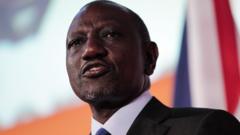Kenya's political landscape has drastically shifted since President William Ruto's rise to power, with a growing wave of discontent among citizens who feel betrayed by unfulfilled promises. Ruto initially gained support from Kenyans longing for change, but just three years into his presidency, he is grappling with a level of public resentment that some analysts say is unparalleled in the country's history.
Recently, Ruto posed a provocative question regarding the public outrage faced by his administration, asking why his predecessors, including former leaders Daniel arap Moi and Uhuru Kenyatta, did not receive the same scrutiny. This query highlights the discontent brewing among Kenyans, who have witnessed a series of violent protests, resulting in casualties and further exacerbating tensions.
The protests have been fueled by factors such as skyrocketing living costs and corruption, leading to rallying cries like "Ruto must go" resonating throughout the nation. Critics argue that Ruto's promises to uplift ordinary citizens have turned sour, with many now accusing him of failing to effectively address pressing issues.
In juxtaposition to Ruto's image as a former common man who overcame adversity, current sentiments echo sentiments of deep-seated disappointment. Ethnic allegiances once thought to be transcended during the elections have resurged, complicating alliances and fueling further anger towards the president.
Social media plays a crucial role in shaping public discourse. Campaigns predominantly led by Kenya’s youth have emerged, capitalizing on digital platforms to foster dissent against the government. Despite the president's attempts to downplay the discontent by calling for unity, the current situation reflects a disconnect between his administration and the realities faced by many Kenyans.
Political communication experts note that the intensity of the backlash against Ruto surpasses historical protests, signaling a unique moment that bridges class and ethnic divides in the societal pushback. However, some analysts believe the traditional notion of leadership and criticism in Kenya still applies, suggesting that Ruto’s experience is part of a broader political cycle.
In light of the continuing unrest, Ruto's government must navigate the complex demands of its citizens while addressing the growing discontent over governance and policy implementations. His administration’s reliance on heavy-handed responses to protests has only served to heighten tensions and distance itself further from the electorate. Observers now watch closely to see how this dissatisfaction translates into future political ramifications for one of Kenya's most scrutinized presidents.





















